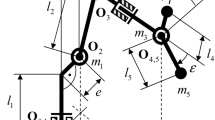Abstract
Much research has recently been dedicated to the control of manipulators (rigid, flexible or with flexible joints) on stationary bases. To enlarge the workspace of manipulators, to avoid obstacles or singularities, and to open new application areas, a new generation of robots has been created. Among them is the mobile manipulator, a manipulator mounted on a vehicle. The consequent base motion and coupling forces not only affect the manipulator's kinematics but also its dynamics. Since it is usually difficult, if not impossible, to model them, an intelligent control method is proposed. The main idea is to design a regular manipulator motion controller that considers the dynamic coupling effects as external disturbances. Robustness is assured not by computation but by estimating and compensating for the coupling effects, along with any other disturbances.
Similar content being viewed by others
References
Armstrong, B., Khatib, O. and Burdick, J. (1986) The explicit dynamic model and inertial parameters of the PUMA 560 arm, in Proceedings of the IEEE International Conference on Robotics and Automation, IEEE Computer Society Press, Los Alamitos, CA, Vol. 1, pp. 51018.
Desoer C. A. and Wang, Y. T. (1980) Linear time-invariant robust servomechanism problem: a self-contained exposition, in Control and Dynamic Systems, Leondes, C. T. (ed.), Academic Press, New York, Vol. 16, pp. 81129.
Friedland, B. (1986) Control Systems Design: An Introduction to State-Space Methods, McGraw-Hill, New York.
Math Works (1994) MATLAB User's Guide, Math Works, Inc., Natick, MA.
Müller, P. C. (1990) Indirect measurement of nonlinear effects by state observers, in Nonlinear Dynamics in Engineering Systems, Schiehlen, W.(ed.), Springer-Verlag, Berlin, pp. 205–15.
Müller, P. C. (1993) Schätzung und Kompensation von Nichtlinearitäten. VDI Bericht 1026, VDI-Verlag,Düsseldorf.
Nenchev, D. N., Yoshida, K. and Uchiyama, M. (1996) Reaction null-space based control of flexible structure mounted manipulator systems, in Proceedings of the IEEE Conference on Decision and Control, IEEE Service Center, Piscataway, NJ, Vol. 3, pp. 411–23.
Tahboub, K. A. (1993) Modeling and control of constrained robots, VDI-Fortschrittsberichte, Series 8, Number 361, VDI-Verlag, Düsseldorf.
Torres, M. A., Dubowsky, S. and Pisoni, A. C. (1994) Path planning for elastically-mounted space manipulators: experimental evaluation of the coupling map, in Proceedings of the IEEE International Conference on Robotics and Automation, IEEE Computer Society Press, Los Alamitos, CA, Vol. 2, pp. 2227–33.
Yamamoto, Y. and Yun, X. (1993) Coordinating locomotion and manipulation of a mobile manipulator, in Recent Trends in Mobile Robots, Zheng, Y. (ed.), World Scientific, pp. 157–81.
Yoshida, K., Nenchev, D. N. and Uchiyama, M. (1985) Moving base robotics and reaction management control. Robotics Research, 7, 100–9.
Author information
Authors and Affiliations
Rights and permissions
About this article
Cite this article
Tahboub, K.A. Intelligent Control for Manipulators with Moving Bases. Journal of Intelligent Manufacturing 9, 1–7 (1998). https://doi.org/10.1023/A:1008815606509
Issue Date:
DOI: https://doi.org/10.1023/A:1008815606509




